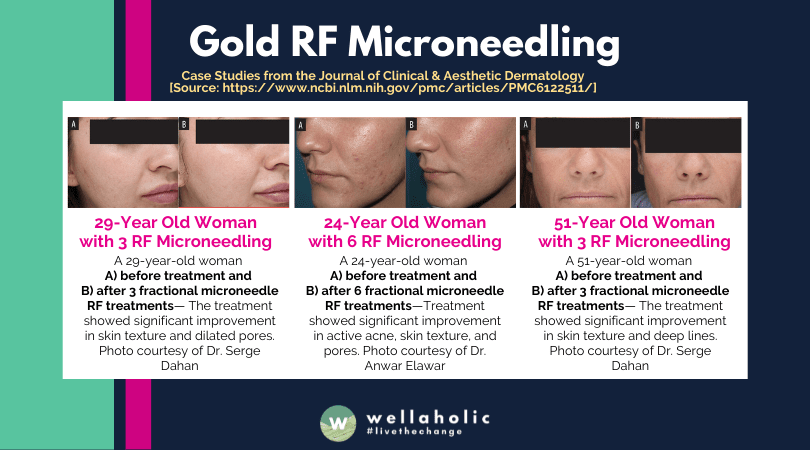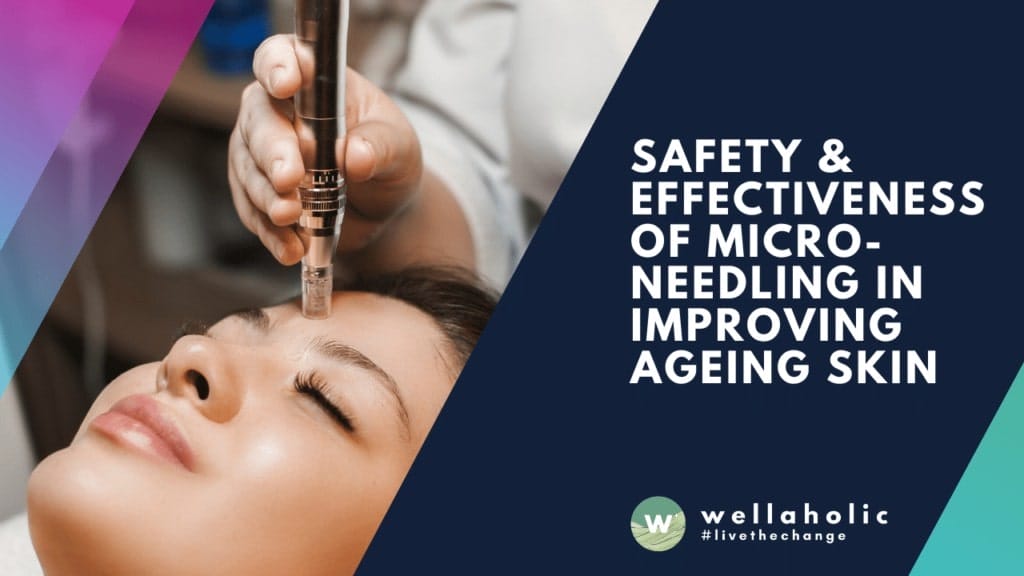
Microneedling Case Study: Safety & Effectiveness in Ageing Skin
Introduction
Abstract from Report published by Glynis Ablon, MD, FAAD on the JCAD or the Journal of Clinical and Aesthetic Dermatology, Aug 2018. [Source]. The purpose of this study was to evaluate the efficacy and safety of an automated microneedling device (Exceed, Amiea Med, MT.DERM GmbH, Berlin, Germany) when used for the rejuvenation of facial skin, as well as to generate data for an FDA 510K submission for the device.
“Microneedling is the key to unlocking younger-looking skin – and it’s never too late to start!”
Participants:
Forty-eight subjects aged 35 to 75 years with signs of facial skin ageing were recruited. After consenting and satisfying inclusion criteria, each subject underwent four microneedling sessions 30 days apart. Subjects were assessed at baseline and at 30, 60, 90, and 150 days after the first treatment.
Measurements:
Wrinkles were assessed using the Lemperle Grading Scale. Skin laxity and texture were assessed using a modified Alexiades-Armenakas Grading Scale. Digital fringe projection technology (PRIMOS) was used to determine skin topography of the periorbital and mesolabial areas.
Results:
Mean improvements in global wrinkle score (mean of nine facial area grades), skin laxity, and skin texture at Day 150, compared to baseline were 1.23 (99% confidence interval [CI]: 1.11, 1.34), 1.09 (99% CI: 0.93, 1.26), and 1.54 (99% CI: 1.33, 1.75), respectively. Statistically significant mean improvements in these three measures were also observed at Day 90. Improvements in wrinkle grading and skin texture were confirmed by the PRIMOS profilometry. The treatment was well tolerated with minimal pain, discomfort, and downtime. Side effects were minor and easily managed.
Conclusion:
This study demonstrates that four microneedling treatments of facial skin, spaced four weeks apart, significantly improve lines, wrinkles, skin laxity and skin texture, 90 and 150 days after the first treatment. The treatment was well tolerated with minimal pain, discomfort, and downtime. Side effects were minor and easily managed compared to other invasive technologies, such as laser ablation and radiofrequency.
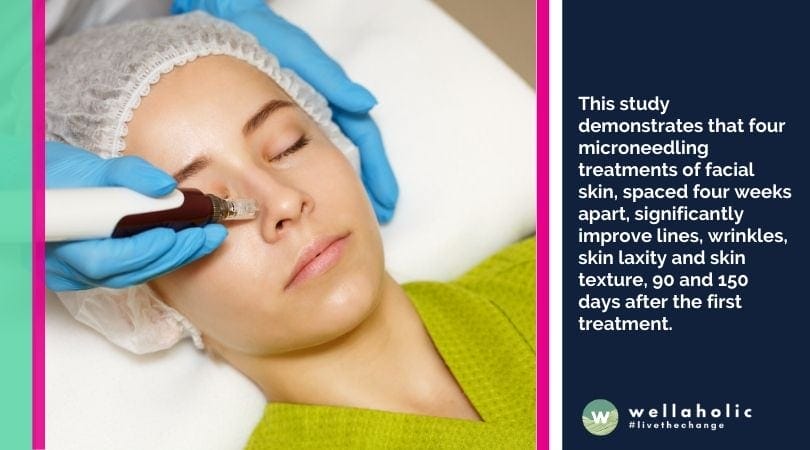
About Microneedling
As the demand for effective, less invasive aesthetic procedures increases, so does the quest for successful solutions. Patients often request therapies to rejuvenate photo-damaged skin, lighten abnormal pigmentation, smooth textural problems, diminish rhytides, and improve skin laxity. This search for younger-looking skin has generated many different cosmetic techniques with varying degrees of invasiveness and efficacy, such as carbon dioxide laser resurfacing, deep chemical peels, and fractionated laser technology.1–4 Predominantly, these techniques work by damaging or causing the destruction of the epidermis, which leads to changes in the dermis that consequently initiate an inflammatory response, resulting in the production of new collagen and skin.5,6 There is, however, a cost to such invasive procedures. Typically, ablative techniques produce thicker bundles of scar collagen rather than the lattice network of collagen found in normal skin. Additionally, ablative procedures can cause the skin to become more sensitive to photo-damage and more susceptible to post-procedural complications.
Microneedling, also known as percutaneous collagen induction (PCI), is a minimally invasive technique that was first described as a principle by Orentreich and Orentreich8 whereby subcutaneous subcision surgery stimulates collagen beneath retracted scars and wrinkles. Fernandes used a similar technique of inserting a 15-gauge needle into the skin under the wrinkles. The technique by Fernandes was followed by the development of the dermal roller.9 A dermal roller is a sterile plastic cylinder with stainless steel needles protruding 1 to 3mm from the surface of the cylinder. The dermal roller is rolled vigorously over the skin to create numerous needle pricks, which lead to thousands of microscopic wounds in the dermis, initiating the natural post-traumatic inflammatory response (i.e., the release of growth factors and the formation of collagen and elastin).
PCI treatment preserves the epidermis while stimulating collagen deposition, thereby reducing the risk of post-treatment complications and patient downtime. Today, PCI treatment can be performed in-office, and patients can resume normal activity the next day.
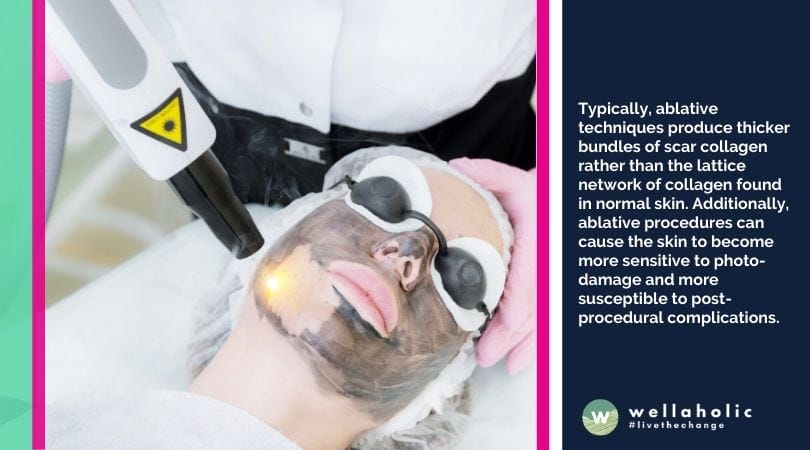
Conditions that respond to microneedling
In addition to age-related skin conditions (e.g., wrinkles, laxity), there is a growing list of dermatological conditions that respond to PCI therapy, including acne scars, dyspigmentation, alopecia, and hyperhidrosis, and use of PCI in transdermal drug delivery have also been reported.
Microneedling device used for case study
The microneedling device used in this study primarily consists of a handpiece, safety needle cartridge, and control unit. The handpiece contains the motor that moves the needles of the safety needle cartridge and a needle depth gauge that allows the user to control the depth of needle incision from 0 to 1.5mm. The control unit allows the user to adjust the frequency of the needle stroke from 100 to 150hz. The safety needle cartridge contains six sterile, single-use, stainless steel microneedles (maximum 1.5mm length, 0.35mm gauge)

Microneedling Treatment protocol
Each subject underwent four microneedling sessions that were 30 days apart. After cleansing the face, a topical anesthetic (LMX 4, Eloquest Healthcare, Ferndale, Michigan) was applied to the entire face and jawline. After 30 minutes, the topical anesthetic was removed by wiping the skin with a cotton pad soaked in 70% isopropyl alcohol, and the skin was allowed to dry. A liberal quantity of Sterile Clear Image singles gel (NEXT Medical Products Company, Branchburg, New Jersey) was applied to the subject’s face to assist the movement of the needle cartridge over the skin, and the needle cartridge was then moved in circular motion across the face. The following needle depths were used to achieve pinpoint bleeding:
- forehead 0.7 to 1.0mm;
- cheek 0.9 to 1.5mm;
- eye area 0.5 to 0.8mm;
- chin 0.9 to 1.3mm;
- glabella and jawline 0.7 to 1.3mm;
- upper lip 0.7 to 1.0mm.
After treatment, the skin was cleansed with warm water and sterile gauze. Subjects were provided instructions for post-skin care, including the use of moisturiser and sun block.
Results of case study
Forty-eight subjects were enrolled in the study, all of whom completed treatment and assessment visits. No subjects withdrew from the study due to issues related to study protocol or AEs. Data from all subjects were included for analysis.
The mean age of the subjects was 55.1 years (range 39–67 years), and the subjects were predominantly female. Fitzpatrick phototypes ranged from I to V with a mean of 2.2. Baseline scores and range for wrinkles, skin laxity, and skin texture were 3.2 (2.2–4), 2.8 (2–3.5), and 2.7 (1.5–3.5), respectively.
The TABLE below shows the mean wrinkle grade for each of the nine assessment areas at baseline and Days 90 and 150, together with summarised changes at follow-up.
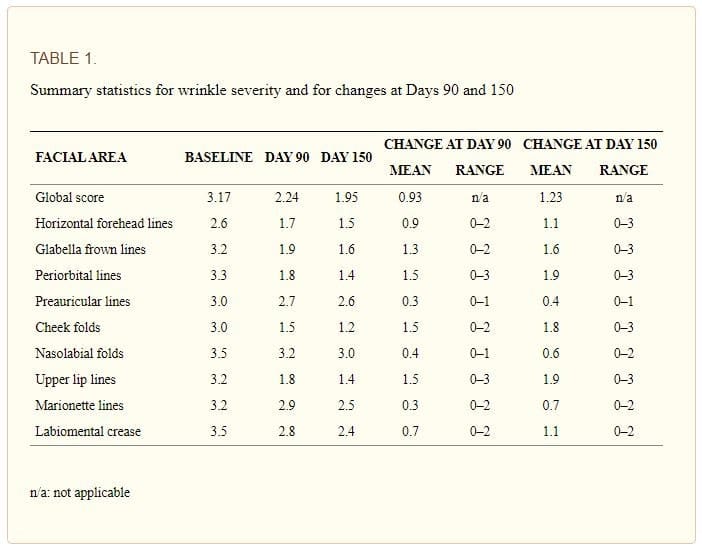
At Day 90, four facial areas had improved by at least one grade—glabella frown lines, periorbital lines, cheek folds, and upper lip lines. The mean improvement in global score was 0.93 (99% CI: 0.81, 1.06).
At Day 150, six of the nine facial areas had improved by at least one grade—horizontal forehead lines, glabella frown lines, periorbital lines, cheek folds, upper lip lines, and labiomental crease. The mean improvement in global score was 1.23 (99% CI: 1.11, 1.34) with p=2.5×106 (i.e., highly significant).
Mean values for line roughness and surface roughness for the periorbital regions and mesolabial regions are shown in Tables 2 and and3.3. At both Day 90 and Day 150 assessment points, mean improvements were observed for all roughness parameters (R# and S#) in both the periorbital and mesolabial regions. Table 4 shows mean skin laxity and skin texture grades at baseline and Days 90 and 150 and mean changes at follow-up. Mean improvement in skin laxity was 0.82 (99% CI: 0.69, 0.95) at Day 90 and 1.09 (99% CI: 0.93, 1.26) at Day 150. A significance test of the mean improvement at Day 150 against 1.0 gave p=0.07, exceeding the study significance level of 0.0083. Mean improvement in skin texture was 1.33 (99% CI: 1.16, 1.51) at Day 90 and 1.54 (99% CI: 1.33, 1.75) at Day 150. Both of these mean values were significantly greater than 1, with p=7.0×106 and p=1.3×108, respectively.
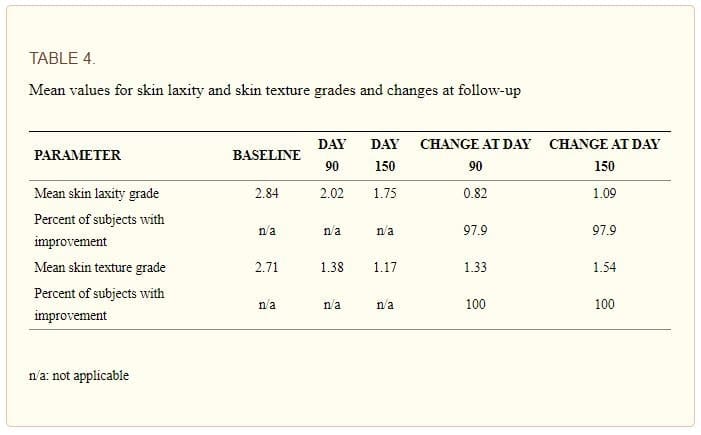
Conclusion of microneedling case study
Microneedling, or PCI, is a relatively simple in-office procedure that appears to be effective in the treatment of facial wrinkles, skin laxity, and skin texture. Past studies using the technique have lacked sufficient numbers of test subjects. Our study, presented here, evaluated a microneedling system for the treatment of facial ageing among a suitably sized sample of patients.
During the procedure, microscopic wounds created in the papillary dermis by the microneedles being driven into the skin result in the normal chemical cascade that follows trauma. This consists of an inflammatory stage, with its subsequent release of cellular growth factors, followed by the proliferative stage, and ultimately the remodeling stage, with the stimulation of neocollagenesis and formation of a tighter collagen matrix.
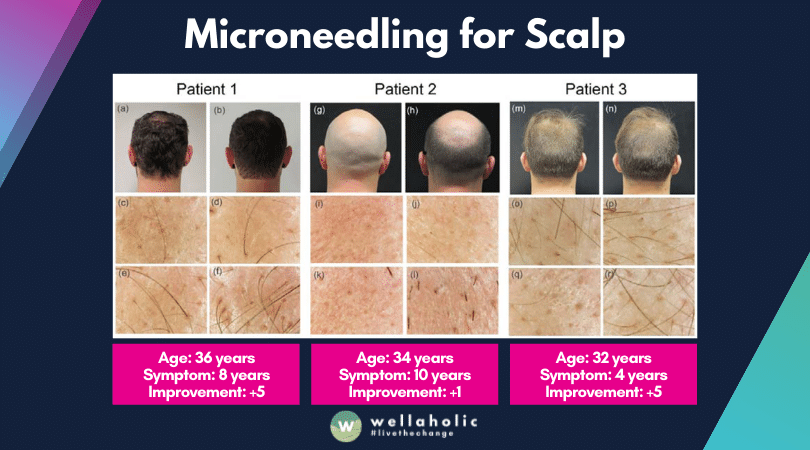
In out study, the subjects demonstrated improvement in facial wrinkles and skin texture at the end of the treatment sequence on Day 90, but with a maximal (statistically significant) effect seen in all three parameters at Day 150. This improvement in facial wrinkles demonstrates the cumulative effect of percutaneous collagen induction and ongoing dermal collagen remodeling, and it confirms previous observations described in the literature.9,10 Improvements in skin laxity are predominantly the result of Collagen III being converted to Collagen I, with the subsequent tightening of the skin. Since this process takes as long as 12 months to complete, it is not surprising that statistically significant results were not seen until Day 150 of our study. Future studies would benefit from an interim follow-up at Day 120 and an extended follow-up period of 6 to 12 months to fully appreciate the potential of this technology. Conversely, statistically significant improvements in skin texture were demonstrated by the end of the treatment course at Day 90. With conversion of Collagen III to Collagen I and subsequent skin tightening, one would expect epidermal remodeling to take place and be more measurable in the earlier stages of PCI treatment, as opposed to the later stages.
Results of wrinkle grading and skin texture improvements were confirmed by 3D profilometry. As expected, the improvement seen in the common roughness indices appeared greater than observer grading measurements. This reflects previously published data by Friedman and Fujiwara. However, the results validate the value and effectiveness of 3D profilometry in providing higher resolution of skin topography than clinical assessment alone, supporting the use of 3D profilometry in measuring improvements that cannot necessarily be identified by a trained rater.
In this study, we demonstrated that four microneedling treatments of facial skin, spaced four weeks apart, produce noticeable improvements in lines and wrinkles, skin laxity, and skin texture at Days 90 and 150 following the first treatment.

Serene Chiam, Aesthetic Director
Serene Chiam is the Aesthetic Director at Wellaholic, a well-known aesthetic chain in Singapore. She has more than ten years of experience in the aesthetics industry. With a Bachelor of Health Science (Aesthetics) and CIDESCO certifications, she expertly combines scientific knowledge with practical skills. Serene is known for her personalized approach to beauty, ensuring each Wellaholic client’s journey is unique and transformative. Her significant contributions have been pivotal in establishing Wellaholic’s reputation for excellence in aesthetic wellness.
Contact Serene at support@wellaholic.com
GET IN TOUCH
Book Now Pay Later

Gold RF Microneedling Facial
- ⭐ Uses Up to 64 Micro Needles. Gold RF Microneedling: Ultimate anti-aging treatment with 64 needles to penetrate the skin, release RF energy, and trigger collagen and elastin production for a clearer complexion and firmer skin
- ⭐ Safe and Minimally Invasive. Gold RF Microneedling is a safe, minimally invasive.
- ⭐ Effectively Treats Acne Scars, Pigmentation & Wrinkles. Extremely effective aesthetic treatment for treating acne scars, pigmentation, fine lines and wrinkles.
- ⭐ Stimulates Collagen Growth. Gold RF Microneedling stimulates collagen and elastin for new, youthful-looking skin.
- ⭐ Award-Winning. Wellaholic’s treatments have been recognized by top beauty publications such as Daily Vanity, Beauty Insider, and Tropika Club Magazine.
- ⭐ Over 2000 Verified Customer Reviews. Wellaholic has over 30 industry awards and over 2000 positive reviews from customers, and >50% are repeat customers.
